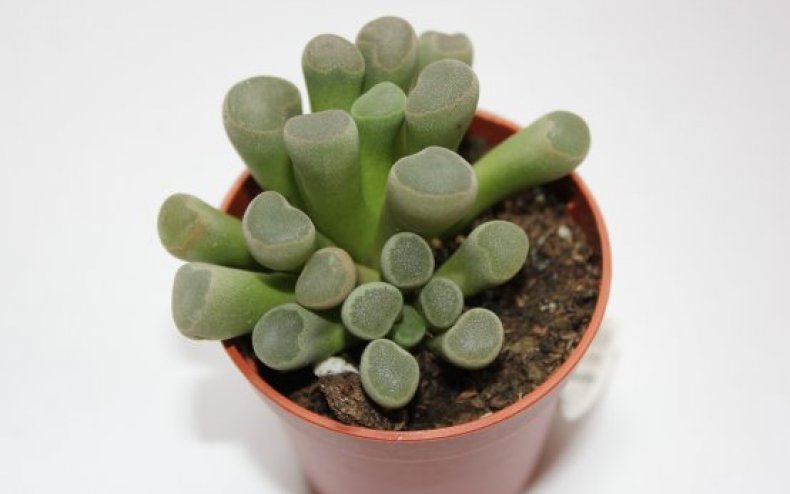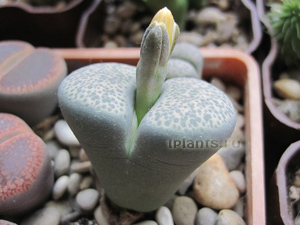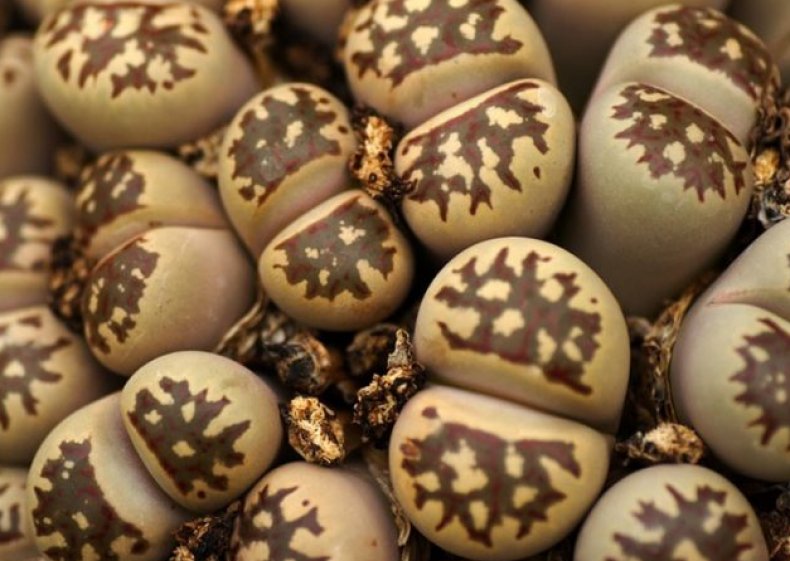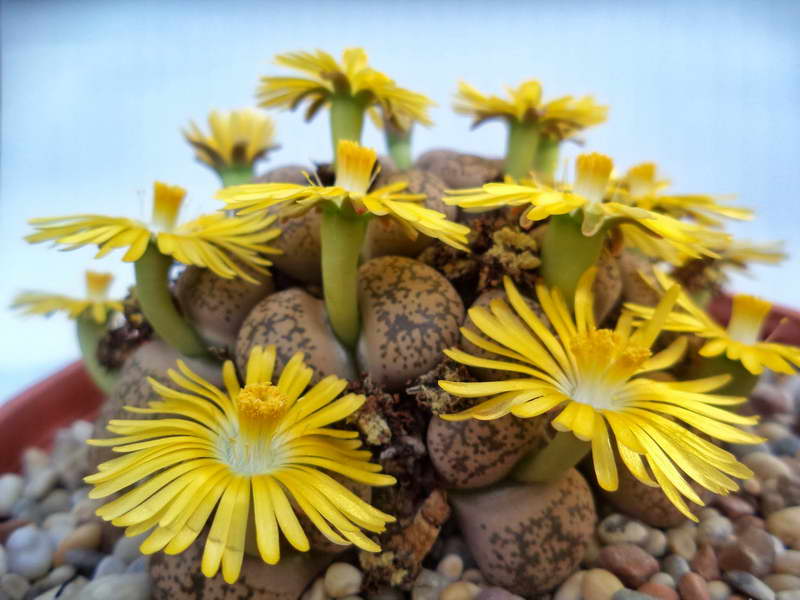Features of care during the rest period
Lithops go through a dormant period twice during the year. The first falls on the change of leaves, when all life processes of the plant slow down significantly, and the main forces are spent on the growth of new leaves.

The second takes place in parallel with the dropping of faded buds, as Lithops rebuild and reconfigure the feeding system.
The rest period lasts, as a rule, 2-3 weeks. At this time, the plant needs special care.
First of all, during this period it is strictly forbidden to feed lithops, watering should also be stopped... This is due to the fact that the slowdown of vital processes primarily concerns the absorption capacity of the root system.
In view of this, the substance and excess water concentrate around the roots of the plant and gradually destroy them, leading the lithops to death.
It is most advisable to put the pot with "living stones" at this time in a light, dry and ventilated place, but reliably protected from drafts.

Lithops - care and cultivation
Temperature: During the period of active growth from February-March to autumn, the usual room temperature. In winter, a dormant period at a temperature of 10-12 ° C, at least 8 ° C, with a dry content. Growing lithops from May to September in the fresh air hardens the plants, makes them stronger and promotes better flowering.

Lighting: Lithops require 4 or 5 hours of direct sunlight in the morning and partial shade in the afternoon. Flowers open in the afternoon when the light starts to dim. Ideal for growing a south or southeast window. Some species need very light shade at noon, which can be done with a thin veil or mosquito net. Shading is also necessary for lithops, who did not receive enough light for some time (in winter), and the sudden spring sun can cause burns. At the same time, if there is no sun for 5-6 days, living stones begin to lose weight and stretch, the lateral part of the leaves acquires a darker shade, the plants may die. Lamps for lighting are suitable fluorescent or LED. They need to be placed at a distance of no more than 10 cm from the plants, and for seedlings at a distance of 5-7 cm.
Lithops who survived a cloudy winter should be taught to the spring sun gradually if they grow on the southern window. On the east and west windows, they do not face sunburn from habit, and the north window is generally not suitable for growing "living stones".
How to Water Lithops: Never let water fall on the leaves and into the hollow between them. You can make the upper drainage from small pebbles, so that the lower part of the Lithops leaves and the upper part of the roots are in the stones, and not in the ground. Watering from a pallet will not completely protect you from excess moisture, since the soil may become too saturated with water. For novice lovers of "living stones", watering from a sump can be too risky: if you pour a little water, it will not reach the roots, if a lot - the likelihood of flooding increases.
Watering Lithops in cycles: The main and most important factor that must be considered in the care of these succulents. Lithops have a specific annual growth cycle
Moistening is only necessary at certain stages of the cycle, and it is equally important to keep the soil dry during dormancy and hibernation.
Lithops are perennial plants that grow a new pair of leaves each year. Active growth - from the end of winter, and in late spring or early summer, living stones begin to hibernate. With colder nights approaching and day length shrinking, lithops are ready to bloom. After it is over, the old leaves will release new ones. Their slow growth continues throughout the winter. Those. this is not a state of complete dormancy, as in many cold wintering plants (cacti and other succulents), but a very slow growing season.
Adult plant care
Despite the exotic appearance, home care for lithops is very simple. Even for novice florists, these "living stones" can grow to their maximum size and please with original flowering.
However, there is an important point - it is necessary to create conditions of detention as close as possible to natural ones. Otherwise, the plant may die.
Watering and spraying
As succulents, lithops can withstand drought well, but cannot tolerate excessive watering.
Due to waterlogging, the plant can rot or burst. During the growth period, watering is carried out once every two weeks.
During the dormant period, which usually lasts from January to March, soil moisture ceases altogether. In March-April, when young leaves appear, and the old ones dry up, watering resumes
It is important that water does not fall on the leaves, as well as into the gap between them.
From time to time, especially on hot days, lithops can be lightly sprayed. However, this should be done early in the morning or late in the evening so that the plant does not get sunburn.
Temperature, humidity and lighting
Inhabitants of deserts, Lithops tolerate summer heat and dry air well. The optimum temperature in the warm season will be 22-25 degrees. In winter, it is reduced to 12-15 degrees, but not lower than 5-7. In the summer, you can take "live stones" out into the fresh air.
Lithops have no special requirements for environmental humidity. They perfectly tolerate dry air. On very hot summer days, you can humidify the air around the plant with a fine-grained spray bottle. But too high humidity and lack of air circulation can provoke rotting.
Lithops are very fond of light, so the southern windows will be the best place for them. They do not respond very well to changes in location, especially during bud formation. Therefore, it is better to rearrange the pot with the plant and not even turn around the axis.
Soil and fertilizer
The soil for lithops should be good for air and moisture, be poor enough. It is better to compose the soil mixture on your own, since peat and substrate for succulents are not very suitable for "living stones".
It is optimal for the mixture to consist of 1 part brick chips, 2 parts sand, 0.5 part leaf earth and 0.5 part clay. There must be drainage at the bottom of the pot. The surface of the soil is covered with fine gravel to avoid decay of the root collar.
Lithops do not need fertilization.
The exceptions are cases when the transplant has not been carried out for more than 2 years. Then feeding can be done in early spring and early autumn with fertilizer for succulents. Concentration - 2 times weaker than indicated on the package.
Transplant and reproduction
Lithops are transplanted in February-March, as the roots fill the pot. As a rule, this is 1 time in 2-4 years. In this case, part of the lateral roots can be removed. Deep pots are used for transplanting, since in nature the roots of a plant grow in depth, and not in breadth.
It is optimal to choose ceramic containers - they do not contribute to stagnation of water. Several specimens of one or more species of lithops can be planted in one pot.
They also go well with representatives of the family Aizova, Asphodel, cacti or some types of milkweed.
Lithops reproduce by seeds. This can be done at any time of the year, but the most optimal time is spring.
Before sowing, the seeds are soaked for 5-6 hours in water, then dried and laid out on the surface of the earth.The container is covered with polyethylene or glass, regularly ventilated, kept at a temperature of 25-28 degrees. If necessary, the soil is moistened with a spray bottle.
After 6-10 days, seedlings appear that do not need to be sprayed. They do not dive right away, but after wintering, in the spring.
Pests and diseases
Lithops can be affected by the scale insect. To combat it, you can use a gruel of water, garlic and soap, which should be wiped off the leaves. Another option is to spray the plant with yarrow infusion. For its preparation, 50 grams of dried grass is poured with 0.5 liters of boiling water and left for 2 days.
Poor drainage and over-watering can cause live rock roots to rot. In this case, the infected roots are cut off, the plant is transplanted into new soil, and watering is significantly reduced. Before transplanting a lithops with bare roots, it is recommended to hold it outdoors for about an hour so that excess moisture evaporates.
Now you know how to grow succulents from seeds at home.
Follow-up care advice
To grow strong seedlings, you need to properly care for the seedlings in the first time after planting. We will tell you how to care for the seedlings so that they grow well and subsequently bloom quickly.
Seedlings in containers are grown under a film, on which condensation forms
Remove the condensation, otherwise the fungus will attack the seedlings and they will die.
Dive the seedlings as soon as 2-4 full leaves appear.
Dive carefully, otherwise you risk damaging the root system.
Water 2-3 times a week. The soil after watering is moist, but not soggy.
Observe the light regime: gradually move from the shade to the light, avoid direct sunlight on the seedlings.
In early spring, take seedlings outside for a couple of hours
This is how the young are tempered. The air temperature is not lower than +20 degrees.
In the spring, seedlings can be planted in open moist soil, for this, prepare the soil, make holes 50 by 50 cm, replant with an earthen clod.
Feed seedlings in the open field with mineral fertilizers, following the instructions on the package. Cover with sawdust or spruce branches for the winter.
If wisteria is shrubby and is intended for growing in the house, you need to create favorable conditions for its maintenance: loose nutritious soil, sunbathing for 5-6 hours a day, proper watering without waterlogging, airing (avoid drafts), transplanting the plant as it grows.
General information
In the wild, plants grow in the South African rocky desert. They can also be found in southwestern Africa. They grow on rocky slopes or areas with clay soil. Often they have a gray tint and are difficult to distinguish among stones, where they hide from the heat.
Lithops have good survival rates. They can grow even where there are no other plants. In the daytime, they are able to withstand up to fifty degrees of heat, and at night a significant drop in temperature, so they are not afraid of temperature changes.
Even a novice florist can grow these unique "living stones". Therefore, if you decide to acquire Lithops, be sure to do so. They will decorate your floral collection and give it an exotic flavor.

Life cycle
The growth period of lithops begins in spring. In June - August, these succulents freeze in development and seem to hibernate. At this time, they do not need to be watered at all. If wrinkles appear on their skin, this indicates a lack of moisture. In this situation, you need to make up for its loss by spraying. After the summer heat subsides, lithops wake up and bloom again. During active growth, they need to be watered twice a month. Lithops prefer to spend winter in a cool and well-lit place.The best place for wintering will be the same sill of the south window. Watering in winter depends entirely on the air temperature in the room where the plant is located. The lower the temperature, the less water the plant needs. When kept indoors, watering should be moderate, since the warm air rising from the batteries is very dry. In February, the rays of the sun are added to the streams of warm air from central heating, which not only shines, but also warms. At such times, Lithops may have an increased need for water.
At the sixth month of life, young plants change leaves. At the first signs of this phenomenon, watering must be completely stopped. Watering can be resumed when the old pair of leaves is dry and looks like paper.
Lithops will delight their owners for decades. These are some of the most durable home grown plants. In one of the famous collections of indoor plants, there is a lithops, which appeared in it around 1918.
Breeding types
Easier and faster rejuvenated reproduces vegetatively. From the mother plant, daughter children-rosettes are split off. It is inappropriate to propagate by seeds. But if there is no way to get a rosette young, then you can try to grow it from seeds.
The seed method of growing a crop implies a long development cycle and a complete loss of the varietal qualities of the flower. This method of propagation is justified only in order to obtain new hybrids with interesting leaf shapes or colors.
Getting seeds on your own is problematic: you need to have simultaneously flowering heterosexual plants and guess the moment of breaking a flower, which only experienced gardeners or breeders can do.
general information
To date, botanists have identified and studied more than a hundred species of lithops - "living stones", which are representatives of the Aiz family.
Cacti are so good at camouflaging that they were discovered by chance. Subsequently, they were studied and the secret of their amazing mimicry was solved - lithops evolved over time, defending themselves from natural ill-wishers - herbivorous animals. They not only "pretend" to be pebbles, but are also able to completely repeat the color of the surrounding landscape.
The plant was named “Lithops” (in Greek “stone”) in 1922, experts focused on their appearance, they really look very much like a scattering of colored pebbles. Like other succulents, they are filled with moisture, valuable in desert and arid areas, store it and use it for life and development in harsh climatic conditions.
Most often, "living stones" have very modest dimensions, their diameter does not exceed 5 cm. They have a very short, almost invisible stem, to which the foliage is attached. Lithops cacti feed on using a long tap root system.
How did this plant attract the attention of flower growers, in addition to its original appearance? First of all, because it does not require laborious home care, caring for lithops is no more difficult than for other succulent plants. And also there are many types of these flowers and you can regularly replenish the collection, and in addition, in the fall they delight with a very spectacular flowering.
Preparatory stage
Echeveria by its origin is southerner, its homeland is considered to be South and Central America, Mexico. Therefore, in order to grow a succulent, he needs to create conditions that will be as close to natural as possible.
Timing
Each plant, like a person, has its own biological rhythm. In Echeveria, the phase of active growth is observed in the spring-summer period. And from October to February, the stone rose goes into a state of rest. Given these rhythms, experts recommend starting planting seeds in late February - early March.
Florists do not recommend knocking down the biological clock of the plant, but if there is a great desire to admire Echeveria in winter, then you can postpone the planting to September-October. In this case, it is necessary to take care of special, greenhouse conditions, implying a sufficient amount of heat and light in severe frosts.
Capacity and soil for planting
For planting succulents, you can purchase a shallow plastic container with a transparent lid. The plant develops well in an ordinary wooden box, organized according to the principle of a greenhouse.
Particular attention must be paid to the soil. To make the seedlings feel comfortable, flower growers recommend taking into account the following points:
- For planting, you can use conventional mixtures, which include a coarse mineral base (fine gravel, sand, agroperlite). It is recommended to add a small amount of granular or crushed coal to such soil.
- A composition that includes the same parts of the following components is considered successful for the development of echeveria: universal peat filler (weakly acidic humus), perlite, sand, crushed coal.
Any soil components can be purchased in specialized stores or taken from the garden, in the forest. But the soil obtained from natural conditions must be disinfected using disinfectant solutions, steaming or roasting procedures.
Sowing material
To guarantee germination of your seeds, you need to use several recommendations from professionals:
Seed selection
When choosing raw materials for planting, it is imperative to pay attention to the packing date. Seeds that are no more than one year old germinate best.
With each subsequent year, the germination of raw materials is significantly reduced.
Disinfection of seeds. To eliminate the risk of developing fungal diseases in the plant, the seeds are placed in a weak solution of potassium permanganate for one day.
Enhanced growth. Special growth stimulants can be purchased at flower shops. They enhance and accelerate the seed germination process. In such solutions, the raw material is soaked (depending on the instructions) for 1-2 hours.
Important! Dry the seeds with regular paper towels before planting.
What conditions to create for growing lithops in the house
According to the reviews of experts and experienced florists, lithops are unpretentious, however, as for any other house plant, it is imperative to create optimal conditions for “flowering living stones”. To this end, you should correctly place the pot with the plant, provide it with proper lighting and temperature conditions.
Location and lighting
The most important factor in keeping a living stone at home is its location and lighting. In the wild, lithops grow exclusively in open sunny areas, so the plant should receive enough natural light at home. For "flowering stones", the best place in the house is where the sun's rays fall for three to four hours a day.
Experts recommend placing a pot of lithops to the south or west windows in the house, and as close to the glass as possible (so that the sun's rays are not refracted).
In winter, when natural light becomes much less, it should be compensated by installing over "living stones" artificial lighting. Fluorescent bulbs are generally best suited. The height of their fastening is from 10 to 15 cm (depending on the lamp power and the size of the lithops).
Did you know? Modern craftsmen and lovers of this plant often practice the option of automated creation of lighting conditions. For this, a pot of lithops is placed under a fluorescent lamp, and it, in turn, is connected to a controlled regulator. - it turns on the lamp in the daytime and turns off at night.This greatly simplifies the home growing process.

Temperature regime
Due to its nature, this exotic plant is much better. tolerates dry weatherthan freezing. Moreover, lithops are very sensitive to a decrease in atmospheric pressure.
In the spring-summer period, when the root system of "living stones" is actively growing, the temperature of their home maintenance should vary within + 20 ... + 25 ° С. In the autumn-winter period, when flowering does not occur, the pot with lithops should be kept at + 12 ... + 15 ° С.
It is noteworthy that an adult plant, like small shoots, loves temperature changes, therefore, in the summer, it is advisable to change the temperature of the content from + 25 ° C during the day to + 15 ° C at night. To do this, just move the pot from the windowsill to the floor. In winter and during the rest period, such procedures are not required.
Did you know? The homeland of Lithops is the hot deserts of South Africa: Namibia, Botswana, South Africa. The climate of these regions is rather harsh and monotonous, since the complete absence of life-giving moisture is aggravated by the fact that no precipitation falls either, and the heat reaches + 50 ° C. It is these conditions that are optimal for the growth of lithops in the wild. However, for home cultivation, milder, more benign conditions must be created.

How to care for lithops

Living stones lithops how to care for succulents at home Reproduction by seeds Photo of flowers
In order to avoid mistakes when keeping lithops, one should understand the cyclical nature and conditions of its growth in the homeland. Living stones are often sold, and the only reason for the low prevalence of these interesting plants is a poor knowledge of their biology and, as a result, improper care, which leads to their death.
It is a very decorative but also extremely sensitive plant. They peek out from under the sandy ground to get their share of the sunlight. These small succulents are extremely varied in color. The top of the leaves is spotty and can be dark red-brown or yellowish, orange, blueberry, dark purple.
Spots, lines and streaks on the surface are a kind of windows through which the plant covered with sand absorbs weak light. With the onset of spring, a pair of new leaves appears from the gap, which replaces the old ones, which have given up their strength to resume growth.
- Lithops feels great on light windowsills, reacts positively to airing.
- He needs direct sunlight or artificial lighting for 12 hours every day for 4 hours.
- In low light, the plant may die.
- In winter, it is worth keeping the temperature at 10-15 degrees. Since December, watering is completely stopped, resuming in March. Lithops can be sprayed only occasionally. Its life cycle ends - it consumes moisture from dying leaves.
- Watering begins in the spring, when a new life cycle begins, resulting in new leaves.
The best way to water is to put water in a pan and after 10 minutes pour out the rest. Or place the container in a bowl with moist peat, which is periodically moistened. At the end of our summer, the life of the lithops stops again - watering should be stopped. In September, lithops bloom, after which watering is reduced again. During the growing season, you can put the container with "pebbles" outside under a canopy to prevent rain drops.
Leaving for a period of rest, it ceases to develop, and its leaves fade. Having noticed these signs, it is worth stopping watering and placing the pots in a bright, cool place.
Twice a year, you can fertilize with complex fertilizer, which should be added to the water for irrigation in minimal quantities. This should only be done for plants that have not been transplanted for more than 2 years.


